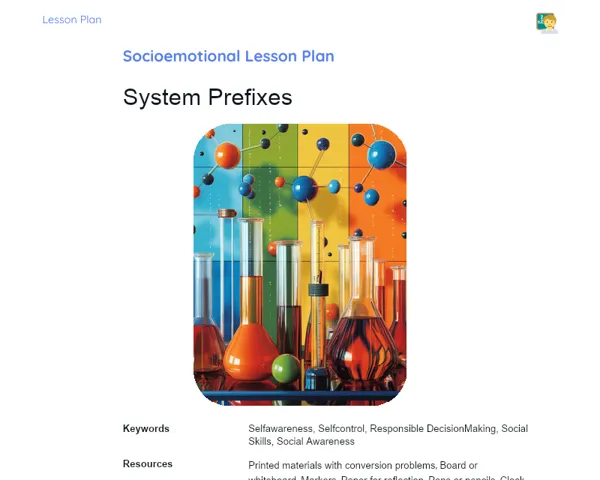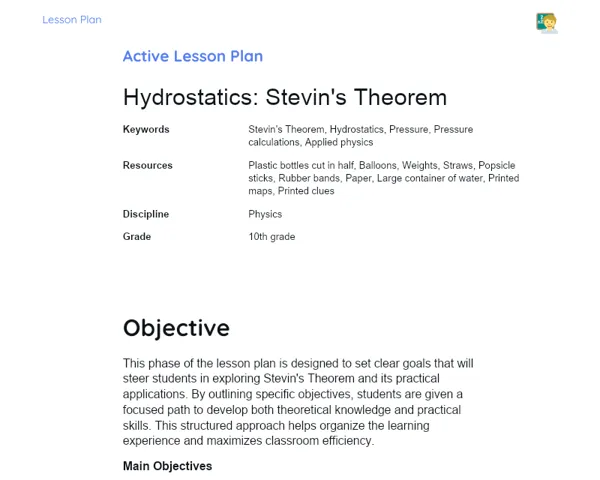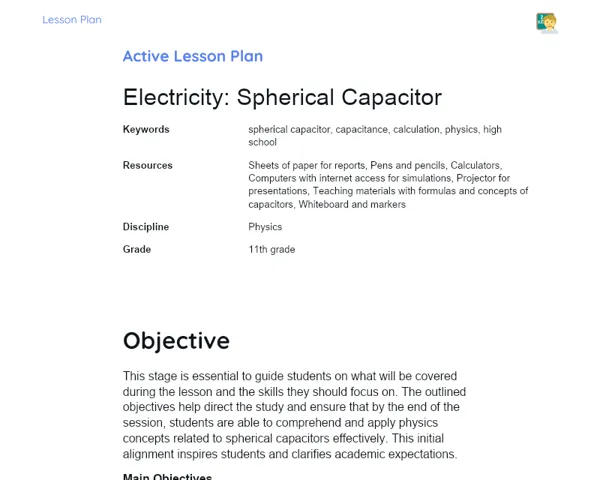Lesson Plan | Lesson Plan Tradisional | Magnetism: Field Lines
| Keywords | Magnetic Field Lines, Magnetism, Earth's Magnetic Field, Electric Current, Bar Magnet, Right-Hand Rule, Practical Applications, Electric Motors, Generators, Transformers |
| Resources | Whiteboard and markers, Projector and computer, Presentation slides, Bar magnets, Compasses, Conductors, Electric current source, Printed or digital diagrams of magnetic fields, Notebook and pen for student notes |
Objectives
Duration: (10 - 15 minutes)
The aim of this section is to give students a strong grasp of the basic concepts surrounding magnetic field lines. By outlining specific objectives, this step ensures that students understand what is expected of them and what they will learn in the lesson. This also aids the teacher in crafting a structured and effective teaching strategy for the topic.
Objectives Utama:
1. Explain the concept of magnetic field lines in a clear and detailed manner.
2. Demonstrate how to identify and draw magnetic field lines in various contexts.
3. Provide practical examples to illustrate the real-world applications of magnetic field lines.
Introduction
Duration: (10 - 15 minutes)
The purpose of this step is to grab students' attention and ignite their interest in the subject, demonstrating the relevance of magnetism in real life. By relating the content to practical situations and intriguing facts, this introduction aims to motivate students to engage more deeply with the topic that will be explored in the lesson.
Did you know?
Did you know that the Earth has a magnetic field similar to a massive magnet? This magnetic field shields our planet from charged particles from the Sun, known as solar wind. It's also due to this magnetic field that compasses have been guiding us for centuries.
Contextualization
To kick off the lesson on magnetic field lines, it's essential to make students aware of the significance of magnetism in our everyday lives. Explain that magnetism is a fundamental force of nature that impacts numerous aspects of our existence, from how compasses help us find directions to the operation of everyday electronic devices like computers and mobile phones.
Concepts
Duration: (50 - 60 minutes)
The aim of this step is to enhance students' understanding of magnetic field lines, offering an in-depth look at their properties and behaviour in various scenarios. Through comprehensive explanations and real-world examples, students will be able to visualize and connect with the theoretical concepts. The posed questions serve to reinforce their learning and ensure that students can apply the knowledge gained to tackle practical problems.
Relevant Topics
1. Definition of Magnetic Field Lines: Explain that magnetic field lines are visual aids that represent the direction and strength of the magnetic field surrounding a magnet or electric current. These lines are conceptual but assist in understanding the behaviour of the magnetic field.
2. Properties of Magnetic Field Lines: Clarify that magnetic field lines always create closed loops, exiting from the north pole and entering the south pole of a magnet. Emphasize that they never intersect, and the density of the lines reflects the strength of the magnetic field.
3. Magnetic Field of a Bar Magnet: Use diagrams to demonstrate how magnetic field lines are arranged around a bar magnet. Show that the lines emerge from the north pole and enter the south pole, forming complete loops.
4. Magnetic Field of the Earth: Explain that the Earth possesses a magnetic field akin to that of a bar magnet. Use illustrations to showcase the Earth’s magnetic field, highlighting its role in protecting our planet from solar wind.
5. Magnetic Field of an Electric Current: Explain how an electric current creates a magnetic field around it. Use the right-hand rule to illustrate the direction of the field lines surrounding a straight conductor.
6. Practical Applications of Magnetic Field Lines: Share examples of practical uses, like how electric motors, generators, and transformers operate. Discuss the importance of understanding magnetic field lines for the design and functioning of these technologies.
To Reinforce Learning
1. Draw the magnetic field lines around a bar magnet. Mark the north and south poles.
2. Explain why magnetic field lines do not cross each other.
3. Using the right-hand rule, determine the direction of the magnetic field lines around a straight conductor carrying an upward electric current.
Feedback
Duration: (20 - 25 minutes)
The goal of this step is to review and consolidate the learning process, ensuring that students have comprehended the concepts discussed during the lesson. A detailed discussion of the answers lets the teacher identify and rectify any misunderstandings, while engagement questions stimulate students to critically reflect on the content and its applications.
Diskusi Concepts
1. Draw the magnetic field lines around a bar magnet. Indicate the north and south poles.: Clarify that the magnetic field lines around a bar magnet exit from the north pole and enter the south pole. Use a diagram to illustrate that the lines form complete loops, travelling from one pole to the other. Stress that the concentration of the lines indicates the strength of the magnetic field: the closer the lines, the greater the magnetic field's strength. 2. Explain why magnetic field lines never cross.: Explain that each point in space can only have one magnetic field direction associated with it. If the lines crossed, it would suggest multiple magnetic field directions at the same point, which is physically impossible. Hence, magnetic field lines never cross. 3. Using the right-hand rule, determine the direction of the magnetic field lines around a straight conductor carrying an upward electric current.: Apply the right-hand rule: if your right hand's thumb points in the direction of the current (up), your fingers curl around the wire in the direction of the magnetic field lines. Therefore, the magnetic field lines create loops around the wire, counterclockwise when viewed from above.
Engaging Students
1. Why is it important that magnetic field lines create closed loops? 2. How can we interpret the strength of the magnetic field using the density of magnetic field lines? 3. In what ways is knowledge of magnetic field lines applied in designing electronic devices? 4. How does an understanding of magnetic field lines assist in navigation technologies? 5. What would be the consequences if magnetic field lines could intersect? What would be the physical implications?
Conclusion
Duration: (10 - 15 minutes)
The aim of this final step is to summarize and consolidate the primary points covered in the lesson, ensuring that students have a clear overview of the content. Additionally, by highlighting the connection between theory and practical applications, this step reinforces the value of the knowledge gained and inspires students to appreciate their learning.
Summary
['Magnetic field lines are visual tools that depict the direction and strength of the magnetic field.', 'Magnetic field lines always form closed loops, emerging from the north pole and entering the south pole of a magnet.', 'Magnetic field lines never intersect, and their density indicates the strength of the magnetic field.', 'The magnetic field around a bar magnet forms lines that exit from the north pole and enter the south pole, creating closed loops.', 'The Earth possesses a magnetic field similar to a bar magnet, which protects it from solar wind.', 'An electric current produces a magnetic field around it, with field lines forming circular patterns around a straight conductor.', 'Real-world applications of understanding magnetic field lines include the operation of electric motors, generators, and transformers.']
Connection
The lesson connected theoretical concepts of magnetic field lines with practical application by demonstrating how to draw and identify these lines in various contexts. Detailed explanations and practical examples illustrated the relevance of these concepts in devices we encounter daily, such as electric motors and generators, facilitating students’ comprehension of the topic's significance in real life.
Theme Relevance
Comprehending magnetic field lines is essential for numerous modern technologies, from compass navigation to the functionality of electronic devices. The interesting facts about the Earth's magnetic field, which safeguards our planet and enables navigation, emphasize the practical implications of the topic. Furthermore, knowledge of magnetic fields is vital for advancing new technologies and scientific innovations.



